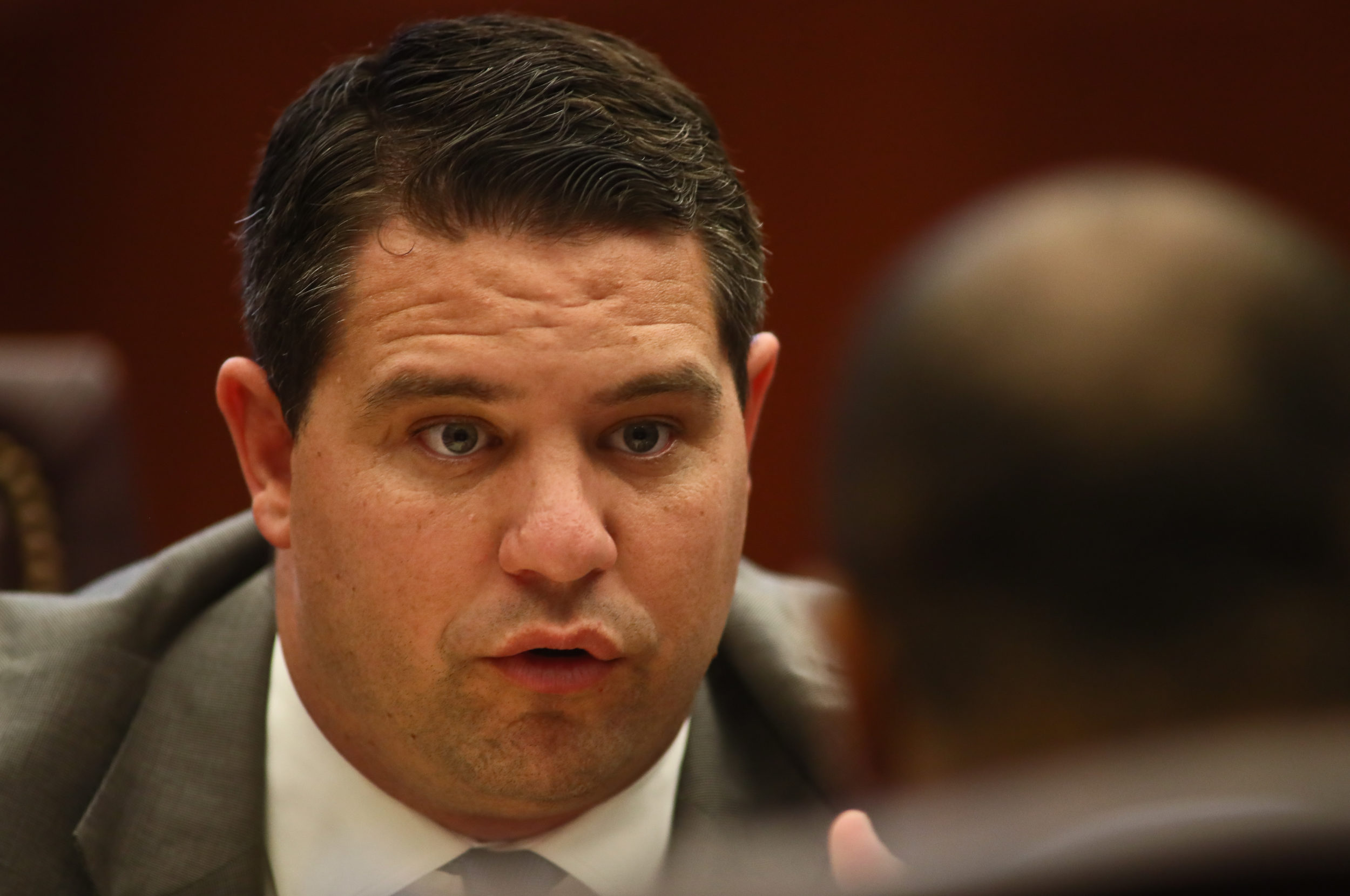
"Temple Destroyers," as John Muir would call them, are popping corks. Devious foreign-funded "developers' won a big victory in the Supreme Court on the WOTUS rule (Waters of the United States). Oligopolist oafs like conflicted developers and their mouthpieces, like conflicted State Senator TRAVIS JAMES HUTSON and his louche lobbyist, former Republican County Commissioner PRISCILLA "RACHAEL" BENNETT are celebrating like it's 1953.
Not so fast, fascists: EPA gets to right wrongs by writing new WOTUS rules.
Fun fact: It was in 2016 that snooty snide County Commission Chair, PRISCILLA "RACHAEL BENNETT (R-HUTSON COMPANIES), then under investigation by the Florida Ethics Commission, who would not allow public comment on the WOTUS rule because it was a "discussion item." Shameful.
The tribe of terrible people greasing chairs in our St. Johns County Commission have done so much harm to our water, forests and wetlands here. But when you consider the swamp-draining corrupters that are doing it nationwide, it boggles the mind.
So much for the first President Bush's promise that there would be no further net destruction of wetlands.
Our wetlands are in peril due to corporate-demanded and corporate-lobbied appointments to our United States Supreme Court by Republican Presidents advised by the likes of the misnamed "Heritage Foundation" and "Federalist Society," the late C. Boyden Gray and Leonard Leo, and the 20-year long purchase of whatever was left of Justice CLARENCE THOMAS's tortured soul, with millions of dollars of hidden "gifts" from billionaire developer HARLAN CROW.
May their tribe be the object of federal grand jury subpoenas and search warrants.
From The Washington Post:
Supreme Court weakens EPA power to enforce Clean Water Act
Justice Samuel A. Alito Jr., writing for a five-justice majority, said the EPA’s interpretation of its powers went too far
Justice Samuel A. Alito Jr., writing for himself and four other of the court’s conservatives, rejected that test and imposed one that environmentalists say will remove millions of acres of environmentally sensitive land from federal regulation.
“We hold that the CWA extends to only those wetlands with a continuous surface connection to bodies that are ‘waters of the United States’ in their own right, so that they are ‘indistinguishable’ from those waters,” Alito wrote, quoting from past court opinions. He was joined by Chief Justice John G. Roberts Jr. and Justices Clarence Thomas, Neil M. Gorsuch and Amy Coney Barrett.
All of the justices agreed that federal regulators went too far in the case at hand, which involved an Idaho couple’s quest to build a home near a lake. But instead of a narrow decision saying just that, the court majority sided with a decades-long effort by property rights groups and businesses to narrow regulations to wetlands and other areas directly connected to “navigable waters” such as rivers and lakes.
Justice Elena Kagan objected on behalf of the court’s liberals, saying her conservative colleagues on Thursday showed the same zeal they had displayed last term in limiting the EPA’s ability to combat climate change.
There, the majority “barred the EPA from addressing climate change by curbing power plant emissions in the most effective way. Here, that method prevents the EPA from keeping our country’s waters clean by regulating adjacent wetlands,” wrote Kagan, joined by Justices Sonia Sotomayor and Ketanji Brown Jackson.
“The vice in both instances is the same: the Court’s appointment of itself as the national decision-maker on environmental policy.”
All three justices joined an opinion by Justice Brett M. Kavanaugh, who had been in the majority in the climate change case.
He wrote that the majority’s new test “departs from the statutory text, from 45 years of consistent agency practice, and from this Court’s precedents” and will have “significant repercussions for water quality and flood control throughout the United States.” He mentioned levee systems along the Mississippi River and projects to clean up the Chesapeake Bay as initiatives that might suffer under the majority’s new rules.
The ruling affects one of the most fundamental authorities at the EPA, its ability to extend protections to upstream waters in order to protect downstream water quality for drinking and wildlife. It will prevent the agency from putting federal protections on as much as 118 million acres of wetlands, an area larger than the landmass of California, according to estimates from the environmental firm Earthjustice.
It gives a win to farmers, home builders and other developers that will now probably find it easier to get permits to build, lawyers and trade groups said. And it probably will force the Biden administration to abandon — or at least restart — an effort it began in 2021 to resolve years of uncertainty with new definitions on the type of waterways EPA rules can protect, leaving more of that power up to state governments, lawyers and legal experts said.
“I don’t see how they get away from that,” said attorney Rafe Petersen, who represents miners, offshore wind developers and others seeking EPA permits for the firm Holland & Knight. “The Biden administration is really boxed into the corner.”
The impact will vary from state to state, said Jonathan H. Adler, a law professor at Case Western Reserve University, depending on how stringently those jurisdictions regulate wetlands and other issues.
Administration officials called the decision a disappointment that erodes long-standing protections. And officials at both the EPA and the White House said administration lawyers will be reviewing the ruling to determine President Biden’s next steps.
The president in a statement called it a “disappointing decision” that “will take our country backwards.”
“Today’s decision upends the legal framework that has protected America’s waters for decades,” Biden said. “It also defies the science that confirms the critical role of wetlands in safeguarding our nation’s streams, rivers, and lakes from chemicals and pollutants that harm the health and wellbeing of children, families, and communities.”
The justices were reviewing for a second time the plans of Michael and Chantell Sackett, who want to build a home on their property near Priest Lake, one of the Idaho’s largest. The EPA says there are wetlands on the couple’s 0.63-acre lot, which makes it subject to the CWA and allows the government to require permits and impose penalties for violations.
Environmental advocates asked the court to retain the government’s authority to protect and regulate waterways that significantly affect downstream water quality and warned that developers would take advantage of weaker regulations. Under the Sacketts’ proposed definition of the law, they said, about half of all wetlands and roughly 60 percent of streams would no longer be federally protected.
Along with other legal observers, Petersen said the latest ruling could have far-reaching consequences. Alito’s decision says the court requires Congress “to enact exceedingly clear language” on rules that may affect private property, which some lawyers said may bring a new level of scrutiny to other bedrock environmental standards aimed at addressing air pollution and climate change.
“This can be read to call into question virtually any modern environmental regulation,” said Sam Sankar, senior vice president for programs at Earthjustice, which filed briefs in the case on behalf of 18 Native American tribes. “Polluters will certainly read this as an indication it’s open season on environmental law.”
Adler said he was unsure about that. “I don’t think there’s anything new” in Alito’s requirement of a clear statement in the law, he said. But he agreed the court is certainly showing a skepticism of agency powers and its broad readings of statutes.
In a sense, the court was revisiting a decision it made 17 years ago, when it also was divided on the question. In that case, Rapanos v. United States, Justice Antonin Scalia wrote for four justices that only wetlands with “a continuous surface connection” to “relatively permanent” bodies of water can be regulated under the law.
But the prevailing test in Rapanos was one from now-retired Justice Anthony M. Kennedy, who said there needs to be only a “significant nexus” between the wetlands and the regulated waters.
Adler noted that none of the justices endorsed the “significant nexus” rule, and Alito’s test in essence substitutes the Scalia test.
Throughout 45 years “and across all eight Presidential administrations, the Army Corps has always included in the definition of ‘adjacent wetlands’ not only wetlands adjoining covered waters but also those wetlands that are separated from covered waters by a manmade dike or barrier, natural river berm, beach dune, or the like,” Kavanaugh wrote. His opinion was joined by Kagan, Sotomayor and Jackson.
“We should not create ambiguity where none exists,” Kavanaugh wrote. “And we may not rewrite ‘adjacent’ to mean the same thing as ‘adjoining,’ as the Court does today.”
The Sacketts, backed by the conservative Pacific Legal Foundation, obtained a local building permit 15 years ago to begin construction on their land, about 300 feet from the lake. Their plot is bounded on two sides by roads and separated from the lake by a row of homes.
The EPA put the plans on hold, threatening fines of more than $40,000 per day if the Sacketts did not stop construction. The couple went to court to block the EPA order and asked the justices to narrow the definition of “waters of the United States” so that their land is not covered by the Clean Water Act.
The fight over what constitutes a wetland subject to the CWA has raged for decades. The George W. Bush administration first issued guidance limiting the reach of the Clean Water Act in 2003 and 2008, after earlier Supreme Court decisions.
In 2015 the Obama administration widened the scope of the law to cover even ephemeral streams and ponds. North Dakota, Wyoming, Alaska and other states immediately sued in federal court, resulting in a nationwide stay from a federal appeals court in Ohio. As the challenges dragged on and led to a slew of different rulings, the Trump-era EPA repealed the rule and in 2019 created a new, weaker one.
The Biden administration has tried to strike a balance by undoing the Trump-era rule and redefining EPA oversight as covering “traditional navigable waters,” including interstate waterways and upstream water sources that influence the health and quality of those waterways.
The case is Sackett v. Environmental Protection Agency.



















2 comments:
Second picture down from the top, the one with Fraud Scott, over the shoulder of the lady wearing the polka dot dress... there's BILLY THE BAMBOOZLER in the background! This guy always lurking around the blue hairs and hogs. He's everywhere at once!
Yeah look at that cheap suit on Bill McClure. I wonder what he might discuss with Fraud Scott... probably the next hot medical and insurance industry grift. The old fashion PILL MILL is kinda fading a bit so we'll be excited to see what BILLY THE BAMBOOZLER does next to diversity ye old buzzard portfolio.
Post a Comment